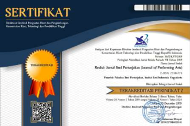Interpretasi Musik Barok Pada Lagu The Trumpet Shall Shound Karya Handel
Abstract
Keywords
Full Text:
PDFReferences
Alfia Nurroza, A. (2022). Analisis Bentuk Lagu “Madiun Kampung Pesilat Indonesia” Ciptaan Hari Subagiyo. Virtuoso: Jurnal Pengkajian Dan Penciptaan Musik, 4(2), 135–147. https://doi.org/10.26740/vt.v4n2.p135-147
Ardipal, A. A. (2015). Kembalikan Lagu Anak-anak Indonesia: Sebuah Analisis Struktur Musik. Panggung, 25(4), 343–355. https://doi.org/10.26742/panggung.v25i4.42
Bahasa, T. P. K. P. P. dan P. (1980). Kamus Besar Bahasa Indonesia. Dekdikbud RI.
Cahya, P. D. (2018). Tinjauan Variasi Melodi dan Struktur Lagu “6 Variations On Folies D” espagne Op.45” Karya Mauro Giuliani. VIRTUOSO (Jurnal Pengkajian Dan Penciptaan Musik), 1(Tinjauan Lagu), 8. https://doi.org/10.26740/vt.v1n2.p42-49
Gutama, A. (2020). Analisis Pola Ritme dan Bentuk Lagu Anak. Virtuoso: Jurnal Pengkajian Dan Penciptaan Musik, 3(1), 23. https://doi.org/10.26740/vt.v3n1.p23-32
Hebert, R. (1959). The Meaning of Art. Penguin Books Ltd.
Hendrik, A. (1965). Hal Ihwal Musik,terjemahan JA Dungga. Penerbit Prajaparamita.
Husna, I. N. (2020). Analisis Teknik Permainan Biola Pada Concerto In A Minor 3RD Movement Rv 356 Op. 3 No. 6 Karya Antonio Vivaldi. Virtuoso: Jurnal Pengkajian Dan Penciptaan Musik, 1(2), 50. https://doi.org/10.26740/vt.v1n2.p50-56
Moleong, L. J. (1999). Metode Penelitian Kualitatif. Remadja Rosdakarya.
Nailiyah, W. M. (2018). Analisis Interpretasi Musik Jaman Barok Pada Prelude From Suite No.1 for Violoncello Solo Karya. 1(1).
Resmana, I. F., & Anggraeni, A. (2018). the Effects of Baroque Music Exposure on Students During Writing a Narrative Text. Erudio Journal of Educational Innovation, 5(1), 87–96. https://doi.org/10.18551/erudio.5-1.11
Roger, K. (1976). Music and Appreciation. Mc. Graww Hill, Inc.
Salsabilla, S. F. (2020). Interpretasi dan Bentuk Penyajian Lagu Habanera Dalam Opera Carmen Karya George Bizet Oleh Heny Janawati. Virtuoso: Jurnal Pengkajian Dan Penciptaan Musik, 3(2), 97. https://doi.org/10.26740/vt.v3n2.p97-109
Sugiyono. (2005). Memahami Penelitian Kualitatif. Alfabeta.
Sugiyono. (2013). Metode Penelitian Pendidikan (Pendekatan Kuantitatif dan Kualitatif). Alfabeta.
Sumarjan, S. (1980). Analisis Kebudayaan (02 (ed.)). Dekdikbud RI.
Surahkmad, W. (2008). Pengantar Penelitian Ilmiah Metode dan Teknik. Tarsito.
Thenadi, J. H., & Sugiarto, R. (2021). Analogical Study of Baroque Architecture and. 05, 240–258.
Thruston, D. (1967). The Interpretation of Music. Huthcinson & Co Ltd.
Wiflihani. (2016). Fungsi Seni Musik dalam Kehidupan Manusia. Anthropos: Jurnal Antropologi Sosial Dan Budaya, 2(1), 101–107. http://jurnal.unimed.ac.id/2012/index.php/anthropo
DOI: https://doi.org/10.24821/resital.v23i1.6758
Refbacks
- There are currently no refbacks.
This work is licensed under a Creative Commons Attribution 4.0 International License.




